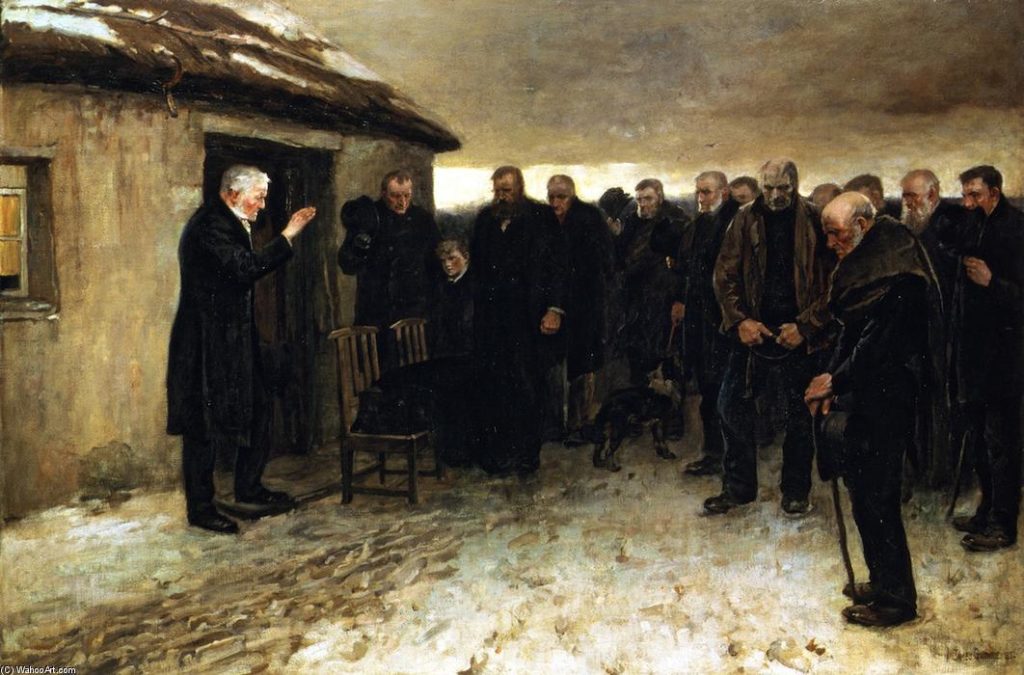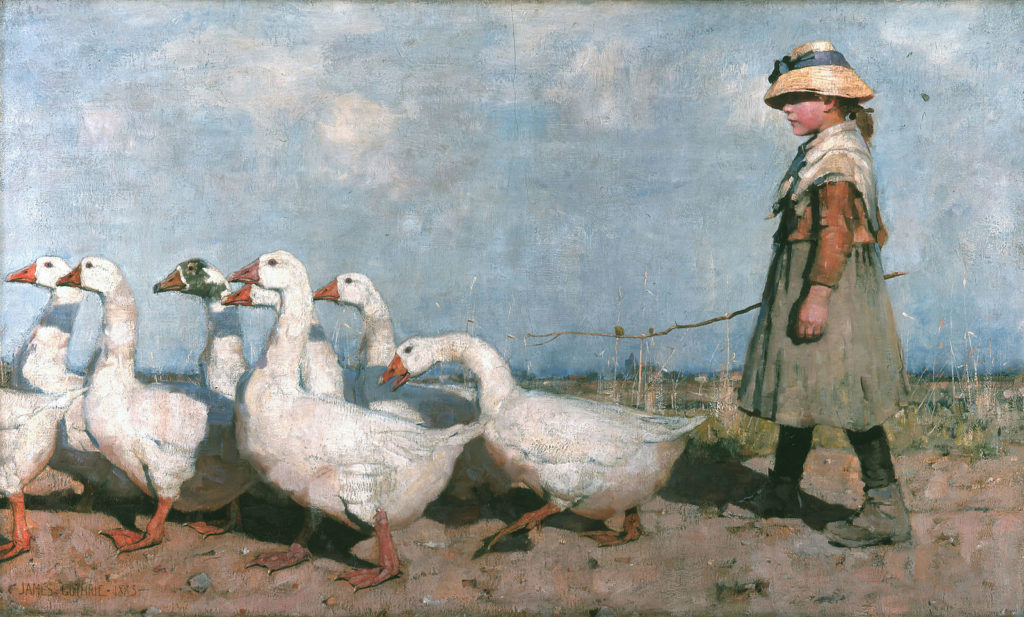Scotland for an Art-Lover
29th April 2021
by Jamie Ellis
It is well known that Scotland is a place of great natural beauty and exciting history.
However, the country also has a strong artistic tradition woven into its rich tapestry.
With the atmospheric wonders of the Highlands and the urban landscapes found
predominantly in the central region, there are many aspects that can be wonderfully
interpreted by an artist.
Because of this, we feel that whether you visit Scotland for the whisky, golf,
rural spaces, or the many other reasons, it is always good to soak up some of the
nation’s beautiful works of art. Fortunately, there are loads of opportunities to do this.
Every major Scottish city has their own iconic galleries which not only showcase
creative talents, but are also indicative of the area they are from.
Edinburgh has the Scottish National Gallery and the Portrait Gallery, which
feature some of the best-known works in Scotland. Glasgow has the Gallery of
Modern Art (GoMA) which focuses on contemporary creative works. There is also
Kelvingrove Art Gallery and Museum, which brings art to life by placing it alongside
historical artefacts. In Dundee, there is the iconic, and newly built, V&A museum
which is dedicated to design. Aberdeen has recently reopened the doors to its
Aberdeen Art Gallery, after being given a multi-million-pound refurbishment.
This means that art can be found and enjoyed in all corners of this wonderful
country. In this article, we will look at three breathtaking Scottish artists who have
creative works that are well worth visiting when you are in Scotland. These are
Henry Raeburn, James Guthrie and Joan Eardley. Through gazing at their work, you
will see that Scotland is the place to be for an art-lover.
Henry Raeburn and the Scottish Enlightenment
Henry Raeburn rose to prominence at the peak of the Scottish Enlightenment. This
was a landmark era where great progress was made with science, philosophy and
economics. In the late 18th and early 19th centuries, individuals began to step away
from the authority of the church and monarchy to realise that they are capable of
free-thought and creating change. The effect of this era’s developments are still felt
today, and they helped to take Scotland, as well as further afield, into the modern
world.
While these major events were happening, it was crucial that there were
painters to document this important period. Possibly the most famous painting of the
Scottish Enlightenment is Raeburn’s ‘The Skating Minister’.

(Source: National Galleries)
While the official title is the lengthy, ‘The Reverend Robert Walker Skating on
Duddingston Loch’, it’s shorter, more informal, name is how it is commonly known.
The Loch still exists to this day, and it is close to the iconic Arthur’s Seat in
Edinburgh. The painting was created during the 1790s and is symbolic of the
changing attitudes to religion at the time. Traditionally, the church had an extremely
oppressive hold on people and held conservative attitudes to recreation. Yet, in ‘The
Skating Minister’ a reverend is seen to be enjoying an activity that is not directly
linked to his faith.
This makes the religious leader seem less fearful, as he is able to step away
from devout religious practice. However, his dark clothing and stiff posture contrast
with the background, and perhaps suggest that more still needed to be done to
create a more approachable image.
The Skating Minister is one of the shining pieces in Edinburgh’s National
Gallery of Scotland. If you find yourself in the inspiring capital, it will be well worth
visiting the work and seeing it for yourself.
James Guthrie and the Glasgow Boys
A century after Raeburn came James Guthrie, a painter that was able to perfectly
visualise various aspects of Scottish life. He was part of a group of groundbreaking
young artists who became known as the ‘Glasgow Boys’. These painters sought to
look for different ways to bring a work of art to life after becoming tired of traditional
methods of British painting.
The desire to find new styles led them to be greatly influenced by Dutch and
French artists – particularly the Realists and Impressionists. This inspired them to
paint the Scottish natural landscape in a whole new light. Guthrie is reported to have
been largely self-taught and if so, he had an innate gift.
A particularly striking painting of his is ‘A Funeral Service in the Highlands’.
This 1883 piece depicts a number of men, across the generations, mourning the
death of a young child who is presumed to also be male.

(Source: Glasgow Museums)
It is a deeply moving painting that shows the men attending a service outside in
harsh conditions. They have their heads bowed and their hats and gloves removed
to pay their respects to the child. It is a sad image that demonstrates how a single
death can shake up a whole community.
However, there is a notable absence of women here. This is likely the case in
order to heighten the sense of remorse from the men’s perspective that a boy who
could have grown up to take on a traditionally male role in the area, is no longer
there. At this point in time, fathers would have trained their sons to take on the family
trade and continue to serve the area. This, in some way, puts the community’s
survival and continuation in jeopardy, as the population in these areas were
dwindling at the time.
Despite the dark subject matter, there is still a great deal of positivity that can
be taken from ‘A Funeral Service in the Highlands’. There is a great sense of unity in
this painting, which reflects how people are known to support one another in the rural
areas of Scotland.
The work is on display at the Kelvingrove Art Gallery in Glasgow. Its large size
dominates the space it is in and attracts the eye. You can spend a long time
contemplating this painting.
For a more upbeat painting of Guthrie’s, there is the excellent ‘To Pastures New’.
Unbelievably, this was painted when Guthrie was just 23 years old. It shows a young
girl herding geese on a nice, clear day. Like the French Realists, the Glasgow Boys
liked to document the grace and virtue of everyday working people. While the child is
wearing modest clothing, she towers over everything else in the painting in a way
that commands respect. ‘To Pastures New’ is viewed by many to be a masterpiece
of its kind, and it is one of the centrepieces of the newly refurbished Aberdeen Art
Gallery.

(Source: Aberdeen Art Gallery)
Joan Eardley: Tackling modern urban life and timeless landscapes
While she may not have the audience size of the previous artists mentioned, Joan
Eardley consistently remains a highly regarded painter by those who have
encountered her. She was a versatile artist that was able to tackle portraits of
children playing in Glasgow Streets, as well as the glorious nature to be found in the
northeast of Scotland. Sadly she died at a young age at just 42 in 1963 from breast-
cancer, however, her work lives on.
The artist spent most of her adult life in Glasgow and the small fishing village
of Catterline, south of Aberdeen. Both experiences played a defining part in her
creative work, and they are now close to both areas’ hearts.
Her 1943 self-portrait is a wonderful example of her strong relationship with
nature. It was made early in her career when she was studying at the Glasgow
School of Art, but it is able to combine her portrait work and her landscapes.

(Source: National Galleries Scotland)
Here, you can see a young Eardley against a rural backdrop. Although it may appear
to look unfinished, it was actually an intended effect by the artist. Eardley was greatly
influenced by Italian frescos and murals and used this style to help blur herself into
nature.
The patches of unpainted canvas, particularly around her hair, look very
similar to the clouds painted in the background. Furthermore, the blue around her
eyes evokes the colour used to create the sky. This helps to blend the character in
the foreground to the landscape in the background.
The painting is a great way of showing how people can connect to Scotland’s
natural beauty. For anybody who visits Scotland, it is always wonderful to immerse
yourself in the landscape. Joan Eardley’s self-portrait is regularly displayed at
Edinburgh’s National Portrait Gallery, and it is common to see people gazing at this
painting for a long period of time.
These are just some works of art that can be discovered when you visit Scotland.
While these are favourites of ours, there is a vast amount of wonderful paintings to
see. This nation is fortunate to have many prestigious art schools that continue to
help produce excellent artists. The Glasgow School of Art, the Edinburgh College of
Art and Grays School of Art in Aberdeen are notable examples. Because of this,
there is an abundance of excellent work to be found.
Furthermore, there are many visitor attractions and accommodations that
feature wonderful examples of Scottish artwork. The Fife Arms in Braemar and
Mount Stuart on the Isle of Bute are just two that are worth mentioning. The Fife
Arms has over 16,000 artefacts to marvel at, and The Mount Stuart has a vast
collection of portraits which include those done by Henry Raeburn. Certainly, you will
be spoilt for choice if you would like a luxury residence with stunning artwork to
enrich your trip.
If you take yourself to Scotland, you will undoubtedly enjoy seeing some
beautiful paintings on your trip. The country is truly a place for an art-lover.
For more on Scotland’s creatives:
Meet some local Scottish creatives from Ardnamurchan
Interview with a Scottish fashion designer: Lorna Gillies